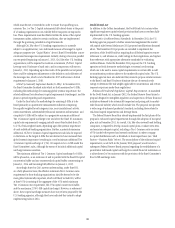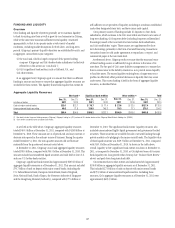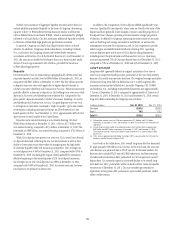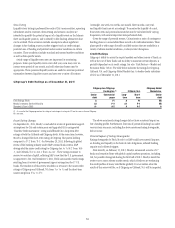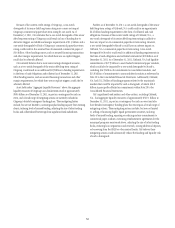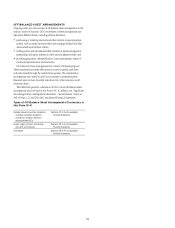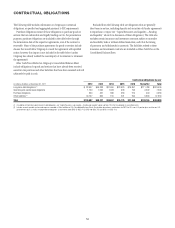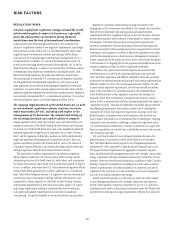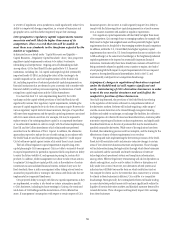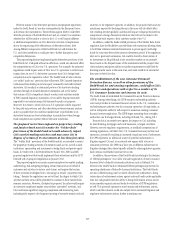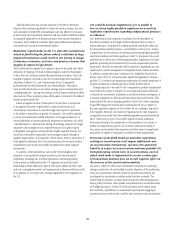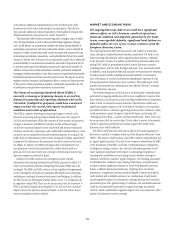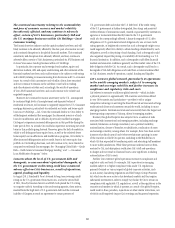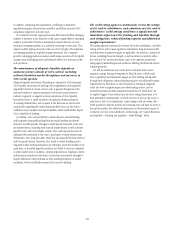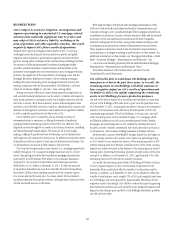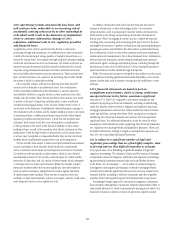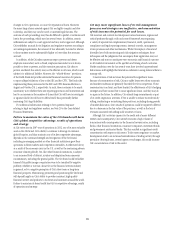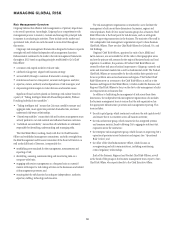Citibank 2011 Annual Report Download - page 78
Download and view the complete annual report
Please find page 78 of the 2011 Citibank annual report below. You can navigate through the pages in the report by either clicking on the pages listed below, or by using the keyword search tool below to find specific information within the annual report.56
or severity of regulations across jurisdictions could significantly reduce Citi’s
ability to compete with foreign competitors, in a variety of businesses and
geographic areas, and thus further negatively impact Citi’s earnings.
Citi’s prospective regulatory capital requirements remain
uncertain and will likely be higher than many of its
competitors. There is a risk that Citi will be unable to
meet these new standards in the timeframe expected by the
market or regulators.
As discussed in more detail under “Capital Resources and Liquidity –
Capital Resources – Regulatory Capital Standards” above, Citi’s prospective
regulatory capital requirements continue to be subject to extensive
rulemaking and interpretation. Ongoing areas of rulemaking include,
among others, (i) the final Basel III rules applicable to U.S. financial
institutions, including Citi, (ii) capital surcharges for global systemically
important banks (G-SIBs), including the extent of the surcharge to be
initially imposed on Citi, and (iii) implementation of the Dodd-Frank
Act, including imposition of enhanced prudential capital requirements on
financial institutions that are deemed to pose a systemic risk to market-wide
financial stability as well as provisions requiring the elimination of credit
ratings from capital regulations and the Collins Amendment.
It is clear that final U.S. rules implementing Basel III, the G-SIB
surcharge and the capital-related provisions of the Dodd-Frank Act will
significantly increase Citi’s regulatory capital requirements, including the
amount of capital required to be in the form of common equity. However, the
various regulatory capital levels Citi must maintain, the types of capital that
will meet these requirements and the specific capital requirements associated
with Citi’s assets remain uncertain. For example, Citi may be required to
replace certain of its existing regulatory capital in a compressed timeframe
or in unfavorable markets in order to comply with final rules implementing
Basel III and the Collins Amendment, which eliminated trust preferred
securities from the definition of Tier 1 Capital. In addition, the alternative
approaches proposed to replace the use of credit ratings in accordance with
the Dodd-Frank Act and final rules implementing Basel II.5 could require
Citi to hold more capital against certain of its assets than it must currently.
The lack of final regulatory capital requirements impedes long-term
capital planning by Citi’s management. Citi is not able to accurately forecast
its capital requirements for particular exposures which complicates its ability
to assess the future viability of, and appropriate pricing for, certain of its
products. In addition, while management may desire to take certain actions
to optimize Citi’s regulatory capital profile, such as the reduction of certain
investments in unconsolidated financial entities, without clarity as to the
final standards, there is risk in management either taking actions based on
assumed or proposed rules or waiting to take action until final rules that are
implemented in compressed timeframes.
Citi’s projected ability to comply with the new capital requirements as they
are implemented, or earlier, is also based on certain assumptions specific
to Citi’s businesses, including its future earnings in Citicorp, the continued
wind-down of Citi Holdings and the monetization of Citi’s deferred tax
assets. If management’s assumptions with respect to certain aspects of Citi’s
businesses prove to be incorrect, it could negatively impact Citi’s ability to
comply with the future regulatory capital requirements in a timely manner
or in a manner consistent with market or regulator expectations.
Citi’s regulatory capital requirements will also likely be higher than many
of its competitors. Citi’s strategic focus on emerging markets, for example, will
likely result in higher risk-weighted assets and thus potentially higher capital
requirements than its less global or less emerging-markets-focused competitors.
In addition, within the U.S., Citi will likely face higher regulatory capital
requirements than most of its U.S.-based competitors that are not subject to the
G-SIB surcharge (or the same level of surcharge) or the heightened prudential
capital requirements to be imposed on systemically important financial
institutions. Internationally, there have already been instances of Basel III not
being consistently adopted or applied across countries or regions. Any lack of
a level playing field with respect to capital requirements for Citi as compared
to peers or less regulated financial intermediaries, both in the U.S. and
internationally, could put Citi at a competitive disadvantage.
As proposed, changes in regulation of derivatives required
under the Dodd-Frank Act will require significant and
costly restructuring of Citi’s derivatives businesses in order
to meet the new market structures and could affect the
competitive position of these businesses.
Once fully implemented, the provisions of the Dodd-Frank Act relating
to the regulation of derivatives will result in comprehensive reform of
the derivatives markets. Reforms will include requiring a wide range of
over-the-counter derivatives to be cleared through recognized clearing
facilities and traded on exchanges or exchange-like facilities, the collection
and segregation of collateral for most uncleared derivatives, extensive public
transaction reporting and business conduct requirements, and significantly
broadened restrictions on the size of positions that may be maintained in
specified commodity derivatives. While some of the regulations have been
finalized, the rulemaking process is still not complete, and the timing for the
effectiveness of many of these requirements is not yet clear.
The proposed rules implementing the derivatives provisions of the Dodd-
Frank Act will necessitate costly and resource-intensive changes to certain
areas of Citi’s derivatives business structures and practices. Those changes
will include restructuring the legal entities through which those businesses
are conducted and the successful and timely installation of extensive
technological and operational systems and compliance infrastructure,
among others. Effective legal entity restructuring will also be dependent on
clients and regulators, and so may be subject to delays or disruptions not
fully under Citi’s control. Moreover, new derivatives-related systems and
infrastructure will likely become the basis on which institutions such as
Citi compete for clients and, to the extent that Citi’s connectivity or services
for clients in these businesses is deficient, Citi could be at a competitive
disadvantage. More generally, the contemplated reforms will make trading
in many derivatives products more costly and may significantly reduce the
liquidity of certain derivatives markets and diminish customer demand for
covered derivatives. These changes could negatively impact Citi’s earnings
from these businesses.


